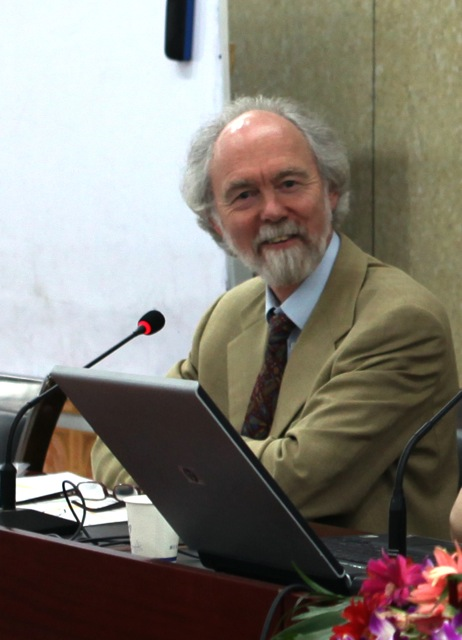涓婚锛�/strong>Confronting the History Problem in Northeast Asia:A View from Outside
鏃堕棿锛�/strong>2015骞�鏈�8鏃ワ紙鏄熸湡浜岋級9:00-11:00
鍦扮偣锛�/strong>绱噾娓牎鍖�钂欐皯浼熸ゼ250 锛圡engminwei Building 250锛�/span>
鏃堕棿锛�/strong>2015骞�鏈�0鏃ワ紙鏄熸湡鍥涳級9:00-11:00
鍦扮偣锛�/strong>绱噾娓牎鍖�瑗�B-112锛岀ぞ浼氱瀛︾爺绌堕櫌浼氳瀹�/span>锛圸ijingang Campus, Xi3-B Building, Room112锛�/span>
鎵垮姙锛�/span>鍥介檯鍏崇郴鍓嶆部绯诲垪璁插骇鐢辨禉姹熷ぇ瀛﹀叕鍏辩鐞嗗闄㈡斂娌诲绯荤粍缁�/span>
| | Prof. Barry Buzan 宸撮噷·甯冭禐鏁欐巿鏄嫳鍥界ぞ浼氱瀛﹂櫌闄㈠+銆佷鸡鏁︽斂娌荤粡娴庡闄DEAS楂樼骇鐮旂┒鍛樸�鏄浗闄呭叧绯婚鍩熷拰鍥介檯瀹夊叏鐮旂┒鐣屼笘鐣岀骇鏉冨▉銆佸摜鏈搱鏍瑰娲惧垱濮嬭�鍜岃嫳鍥藉娲鹃鍐涗汉鐗┿�鏇句换浼︽暒鏀挎不缁忔祹瀛﹂櫌钂欏鑲�middot;浼】鍥介檯鍏崇郴鏁欐巿锛岃嫳鍥藉浗闄呯爺绌跺崗浼氫富甯紙1988-1990锛夛紱锛堝寳缇庯級鍥介檯鐮旂┒鍗忎細鍓富甯紙1993-1994骞达級锛涖�娆ф床鍥介檯鍏崇郴鏉傚織銆嬩富缂栵紙2004-2008锛夈� |
| 鍏朵唬琛ㄤ綔鍖呮嫭锛氥�浜烘皯銆佸浗瀹跺拰鎭愭儳锛氬浗闄呭叧绯讳腑鐨勫浗瀹跺畨鍏ㄩ毦棰樸�锛�983骞达級銆併�瀹夊叏锛氫竴绉嶅垎鏋愮殑鏂版鏋躲�锛�998骞达紝涓庡ゥ鍒�middot;缁村紬鍜岄泤鏅�middot;寰�middot;鐜嬪皵寰峰悎钁楋級銆併�涓栫晫鍘嗗彶涓殑鍥介檯浣撶郴锛氶噸寤哄浗闄呭叧绯荤爺绌躲�锛�000骞达紝涓庣悊鏌ュ痉·鍒╃壒灏斿悎钁楋級銆併�浠庡浗闄呯ぞ浼氬埌涓栫晫绀句細锛熴�锛�004骞达級銆併�鍥介檯瀹夊叏鐮旂┒鐨勬紨鍖栥�锛�009骞达紝涓庣惓濞�middot;姹夋.鍚堣憲锛夊拰 銆婂叏鐞冭浆鍨嬶細浠庡崄涔濅笘绾殑瑙嗚鍙嶆�鍥介檯鍏崇郴鐞嗚銆嬶紙2015锛夌瓑銆�/span> | |
Confronting the History Problem in Northeast Asia:
A View from Outside
This set of two lectures provides an alternative approach to addressing the history problem between China and Japan. Its method is to construct a historical overview of Northeast Asia (NEA) that integrates the local histories with the collective global one, and provides a common normative platform for assessing who did what since 1840. It aims to open a debate within the region about the history problem by challenging the prevailing politics of blame and recrimination against others in two ways. First, the historical overview is constructed as a kind of balance sheet into which the particular disputes at the centre of the history problem can be placed into a wider context of both world historical developments and systematic normative judgment. Second, in the context of this balance sheet, all the peoples concerned are invited not just to look critically at themselves as well as at others, but also to be aware of the positive contributions that others, as well as themselves, have made to the modern history of the region. The global history framework aims to put Northeast Asian history into shared context and show how while NEA has largely solved the big history problem of its dual encounter with the West and modernity, it has failed to solve the smaller, local history problem generated by that dual encounter, and both the states and peoples of the region, and the rest of the world, are paying a heavy price for that. The normative framework for assessment aims to be broadly acceptable to the peoples in NEA and consists of five goals: ridding Asia of Western imperialism/hegemony; increasing the absolute and relative wealth and power of Asian states and societies; restoring respect for Asian nations and their rightful place in international society; promoting respectful relationships with their neighbours on the basis of sovereign and racial equality; and promoting the broadly Confucian ideal of an orderly, peaceful and harmonious domestic society. The paper argues that when NEA’s history is seen through these lenses, there are no obvious heroes or villains. Instead there is a complex and densely connected joint story in which both countries (and also the West and Korea) have deeply mixed records, making positive contributions in some ways and negative ones in others. NEA’s shared story in its dual encounter is much more important than the stories of the individual countries. Perhaps not surprisingly, placing the local histories into the larger picture of the global transformation exposes many profound similarities between the structural positions and trajectories of Japan and China. These similarities might provide a foundation on which the two countries could begin to build a solution to their history problem, and so open the path towards the peaceful and stable region they both say they want.


